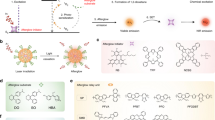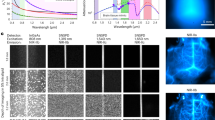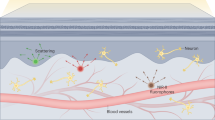Abstract
In the second near-infrared spectral window (NIR-II; with wavelengths of 1,000–1,700 nm), in vivo fluorescence imaging can take advantage of reduced tissue autofluorescence and lower light absorption and scattering by tissue. Here, we report the development and in vivo application of a NIR-II phosphorescent probe that has lifetimes of hundreds of microseconds and a Stokes shift of 430 nm. The probe is made of glutathione-capped copper–indium–selenium nanotubes, and in acidic environments (pH 5.5–6.5) switches from displaying fluorescence to phosphorescence. In xenograft models of osteosarcoma and breast cancer, intravenous or intratumoral injections of the probe enabled phosphorescence imaging at signal-to-background ratios, spatial resolutions and sensitivities higher than NIR-II fluorescence imaging with polymer-stabilized copper–indium–sulfide nanorods. Phosphorescence imaging may offer superior imaging performance for a range of biomedical uses.
This is a preview of subscription content, access via your institution
Access options
Access Nature and 54 other Nature Portfolio journals
Get Nature+, our best-value online-access subscription
$29.99 / 30 days
cancel any time
Subscribe to this journal
Receive 12 digital issues and online access to articles
$99.00 per year
only $8.25 per issue
Buy this article
- Purchase on Springer Link
- Instant access to full article PDF
Prices may be subject to local taxes which are calculated during checkout






Similar content being viewed by others
Data availability
The main data supporting the results of this study are available within the paper and its Supplementary Information. The raw and analysed datasets are available in Figshare at https://doi.org/10.6084/m9.figshare.14633316 (ref. 29). Source data are provided with this paper.
References
Antaris, A. L. et al. A small-molecule dye for NIR-II imaging. Nat. Mater. 15, 235–242 (2016).
Hu, Z. H. et al. First-in-human liver-tumour surgery guided by multispectral fluorescence imaging in the visible and near-infrared-I/II windows. Nat. Biomed. Eng. 4, 259–271 (2020).
Chen, X. H., Chen, Y. X., Xin, H. H., Wan, T. & Ping, Y. Near-infrared optogenetic engineering of photothermal nanoCRISPR for programmable genome editing. Proc. Natl Acad. Sci. USA 117, 2395–2405 (2020).
Wang, W. et al. Metabolic labeling of peptidoglycan with NIR-II dye enables in vivo imaging of gut microbiota. Angew. Chem. Int. Ed. 59, 2628–2633 (2020).
Fan, Y. et al. Lifetime-engineered NIR-II nanoparticles unlock multiplexed in vivo imaging. Nat. Nanotechnol. 13, 941–946 (2018).
Zhang, M. et al. Bright quantum dots emitting at ∼1,600 nm in the NIR-IIb window for deep tissue fluorescence imaging. Proc. Natl Acad. Sci. USA 115, 6590–6595 (2018).
Lei, Z. et al. Stable, wavelength-tunable fluorescent dyes in the NIR-II region for in vivo high-contrast bioimaging and multiplexed biosensing. Angew. Chem. Int. Ed. 58, 8166–8171 (2019).
Shapiro, A. et al. Tuning optical activity of IV–VI colloidal quantum dots in the short-wave infrared (SWIR) spectral regime. Chem. Mater. 28, 6409–6416 (2016).
McHugh, K. J. et al. Biocompatible semiconductor quantum dots as cancer imaging agents. Adv. Mater. 30, 1706356 (2018).
Zhu, S. J. & Chen, X. Y. Overcoming the colour barrier. Nat. Photonics 13, 515–516 (2019).
Su, Y. et al. Ultralong room temperature phosphorescence from amorphous organic materials toward confidential information encryption and decryption. Sci. Adv. 4, eaas9732 (2018).
Zhao, W. J. et al. Boosting the efficiency of organic persistent room-temperature phosphorescence by intramolecular triplet–triplet energy transfer. Nat. Commun. 10, 1595 (2019).
Xu, J. et al. Large-scale synthesis of long crystalline Cu2-xSe nanowire bundles by water-evaporation-induced self assembly and their application in gas sensing. Adv. Funct. Mater. 19, 1759–1766 (2009).
Xu, J. et al. Large-scale synthesis and phase transformation of CuSe, CuInSe2, and CuInSe2/CuInS2 core/shell nanowire bundles. ACS Nano 4, 1845–1850 (2010).
Urano, Y. et al. Selective molecular imaging of viable cancer cells with pH-activatable fluorescence probes. Nat. Med. 15, 104–109 (2009).
Xia, Y. S. et al. Self-assembly of self-limiting monodisperse supraparticles from polydisperse nanoparticles. Nat. Nanotechnol. 6, 580–587 (2011).
Mou, M. et al. Aggregation-induced emission properties of hydrothermally synthesized Cu–In–S quantum dots. Chem. Commun. 53, 3357–3360 (2017).
Jara, D. H., Stamplecoskie, K. G. & Kamat, P. V. Two distinct transitions in CuxInS2 quantum dots. Bandgap versus sub-bandgap excitations in copper-deficient structures. J. Phys. Chem. Lett. 7, 1452–1459 (2016).
Liu, X., Braun, G. B., Qin, M., Ruoslahti, E. & Sugahara, K. N. In vivo cation exchange in quantum dots for tumor-specific imaging. Nat. Commun. 8, 343 (2017).
Yu, M. X. & Zheng, J. Clearance pathways and tumor targeting of imaging nanoparticles. ACS Nano 9, 6655–6674 (2015).
Zhang, R. R. et al. Beyond the margins: real-time detection of cancer using targeted fluorophores. Nat. Rev. Clin. Oncol. 14, 347–364 (2017).
Li, J. & Pu, K. Semiconducting polymer nanomaterials as near-infrared photoactivatable protherapeutics for cancer. Acc. Chem. Res. 53, 752–762 (2020).
Zhang, K. Y. et al. Long-lived emissive probes for time-resolved photoluminescence bioimaging and biosensing. Chem. Rev. 118, 1770–1839 (2018).
Gu, Y. Y. et al. High-sensitivity imaging of time-domain near-infrared light transducer. Nat. Photonics 13, 525–531 (2019).
Xu, G. et al. New generation cadmium-free quantum dots for biophotonics and nanomedicine. Chem. Rev. 116, 12234–12327 (2016).
Heiden, M. G. V., Cantley, L. C. & Thompson, C. B. Understanding the Warburg effect: the metabolic requirements of cell proliferation. Science 324, 1029–1033 (2009).
Wang, Y. G. et al. A nanoparticle-based strategy for the imaging of a broad range of tumours by nonlinear amplification of microenvironment signals. Nat. Mater. 13, 204–212 (2014).
Zhao, T. et al. A transistor-like pH nanoprobe for tumour detection and image-guided surgery. Nat. Biomed. Eng. 1, 0006 (2017).
Chang, B. et al. A phosphorescent probe for in vivo imaging in the second near-infrared window. Figshare https://doi.org/10.6084/m9.figshare.14633316 (2021).
Acknowledgements
This work was supported by the National Natural Science Foundation of China (51803161, 51533007 and 61622117), National Key Research and Development Program of China (2017YFA0205200), Office of Science Biological and Environmental Research Program, US Department of Energy (DE-SC0008397) and National Cancer Institute Centers of Cancer Nanotechnology Excellence grant CCNE-TR U54 CA119367.
Author information
Authors and Affiliations
Contributions
Z.C., B.C. and T.S. conceived of and designed the study, supervised the project and wrote the manuscript. B.C. performed all of the experiments. Z.H. and J.T. assisted with the design of the study and analysed the data. R.L. and H.L. assisted with the biosafety evaluation. D.L. and C.Q. helped with the animal imaging. Y.R. assisted with the in vitro studies. X.S. contributed to structural analysis by TEM. All authors discussed the results and commented on the manuscript.
Corresponding authors
Ethics declarations
Competing interests
The authors declare no competing interests.
Additional information
Peer review information Nature Biomedical Engineering thanks Zhen Chao Dong and the other, anonymous, reviewer(s) for their contribution to the peer review of this work. Peer reviewer reports are available.
Publisher’s note Springer Nature remains neutral with regard to jurisdictional claims in published maps and institutional affiliations.
Supplementary information
Supplementary Information
Supplementary Methods, Discussion, Figs. 1–33, Tables 1–3, References and captions for Supplementary Videos 1–4.
Video 1
In vivo video-rate NIR-II intensity imaging of a nude mouse bearing 143B tumours, in lateral position at 24 h post-injection of CISe nanotubes.
Video 2
In vivo video-rate NIR-II intensity imaging of a nude mouse bearing 143B tumours, in supine position at 24 h post-injection of CISe nanotubes.
Video 3
In vivo video-rate NIR-II intensity imaging of a nude mouse bearing 143B tumours, in lateral position at 24 h post-injection of PEG-CIS nanorods.
Video 4
In vivo video-rate NIR-II intensity imaging of a nude mouse bearing 143B tumours, in supine position at 24 h post-injection of PEG-CIS nanorods.
Source data
Source Data Fig. 2
Source data.
Source Data Fig. 3
Source data.
Source Data Fig. 5
Source data.
Source Data Fig. 6
Source data.
Rights and permissions
About this article
Cite this article
Chang, B., Li, D., Ren, Y. et al. A phosphorescent probe for in vivo imaging in the second near-infrared window. Nat. Biomed. Eng 6, 629–639 (2022). https://doi.org/10.1038/s41551-021-00773-2
Received:
Accepted:
Published:
Issue Date:
DOI: https://doi.org/10.1038/s41551-021-00773-2



